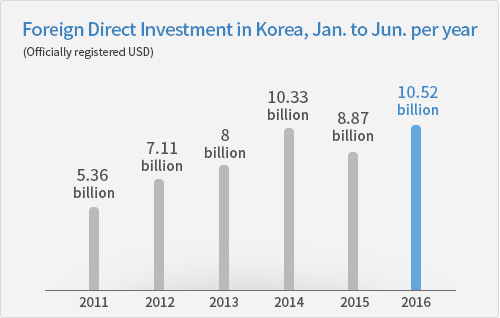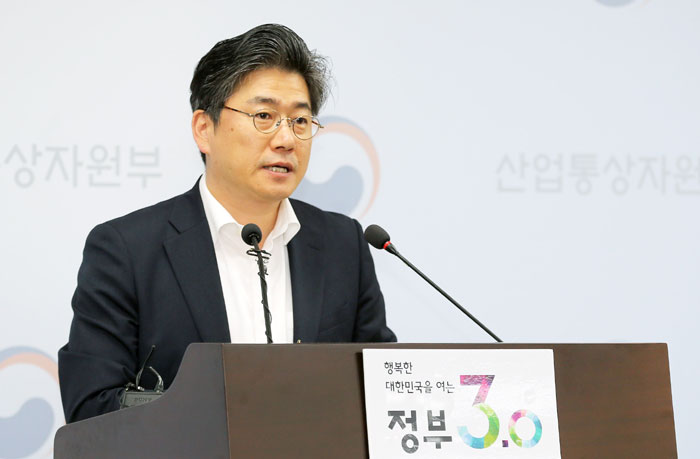-
 Korea.net's 24-hour YouTube channel
Korea.net's 24-hour YouTube channel- NEWS FOCUS
- ABOUT KOREA
- EVENTS
- RESOURCES
- GOVERNMENT
- ABOUT US
Foreign direct investment (FDI) into Korea hit a record high in the first half of this year.
The Ministry of Trade, Industry and Energy announced on July 4 that the officially registered amount of FDI in the first half of the year rose by 18.8 percent to USD 10.52 billion, compared to the same period last year that saw USD 8.87 billion. This is now the largest amount of FDI received in a January-June period ever since the government began to record statistics in 1962.

By sector, FDI into the manufacturing sector was worth USD 2.58 billion, showing the highest increase of 159.6 percent year-on-year. FDI into the service sector hit USD 7.24 billion, jumping 13.7 percent over the same period last year.
More than 74 percent of the FDI that went into the manufacturing sector, some USD 2.13 billion, was concentrated on transportation, such as R&D into electric vehicles, electronics and electricity, and chemical engineering.
In regard to the FDI that went into the service sector, more than 79 percent of it, some USD 5.73 billion, was injected into finance, insurance and business services, such as IT services, advertising, design, consulting and real estate commissions.
These statistics for January to June this year also saw extended investment into parts and materials, IT services, and new industries, such as biotech, healthcare, and secondary batteries and electric car propulsion systems.
Korea attracted USD 0.225 billion worth of FDI that went into building plants and production lines for manufacturing the separation films used in secondary batteries. This is partly to meet China’s growing demand for electric cars. Some USD 0.97 billion worth of FDI went into establishing a propylene plant for SK-Advanced, an optics company. The country also attracted USD 0.75 billion from Japan’s Toray Battery Separator Film (BSF) company to build a plant that will build separation films for secondary batteries.

A lot of the FDI that went into building new assembly lines and production facilities was backed by free trade agreements (FTAs). Korea received FDI worth USD 0.1 billion to build a factory that can produce carbon fiber composite materials, a step to penetrating further into the mainland Chinese market. The nation also saw increased investment, worth USD 0.17 billion, in extending factories that conduct follow-up processes for semiconductor packaging and testing.
Increased investment from the EU and China is another reason for Korea’s increased FDI. Overall, companies from the EU invested some USD 4.21 billion into Korea between January and June this year, soaring 221 percent over the same statistic last year. China’s investment into Korea was worth USD 0.71 billion, rising 79.5 percent over the same statistic last year. About 60 to 70 percent of EU companies use Korea as a stepping stone to access the Chinese market. They generally locate factories or R&D centers in Korea in order to then bring their products into China, instead of entering the Chinese market directly.
Investment in media has also helped Korea attract more FDI, especially because of the recent Korea-China FTA. Much of this increased FDI is aimed at Chinese or Southeast Asian markets. Companies hope to take advantage of Korea’s skilled human resources, technology, knowhow, brands and content, and then export it elsewhere in Asia. In fact, the nation recorded M&As worth some USD 0.43 billion that covered the production of content in Korea, such as sound sources, performances, TV soap operas and the appearance of celebrities in China or Southeast Asia. There were also joint ventures worth USD 0.175 billion in the video game industry, which, again, is aimed at the Chinese mobile and online games markets.
Deputy Trade Minister Cheong Seung-il said in the July 4 press briefing that, “Despite a downturn and deepening uncertainties concerning the world economy, foreign investors trust the fundamentals of the Korean economy and see potential growth in new industries.”
“Korea is the only OECD country that has FTAs with the U.S., the EU and China. Such free trade pacts encourage many non-Korean investors to use Korea as a production base,” he concluded.
By Yoon Sojung
Korea.net Staff Writer
Photo: Ministry of Trade, Industry and Energy
arete@korea.kr
The Ministry of Trade, Industry and Energy announced on July 4 that the officially registered amount of FDI in the first half of the year rose by 18.8 percent to USD 10.52 billion, compared to the same period last year that saw USD 8.87 billion. This is now the largest amount of FDI received in a January-June period ever since the government began to record statistics in 1962.

FDI coming into Korea between January to June this year hit a record high of USD 10.52 billion. (Source: Ministry of Trade, Industry and Energy)
By sector, FDI into the manufacturing sector was worth USD 2.58 billion, showing the highest increase of 159.6 percent year-on-year. FDI into the service sector hit USD 7.24 billion, jumping 13.7 percent over the same period last year.
More than 74 percent of the FDI that went into the manufacturing sector, some USD 2.13 billion, was concentrated on transportation, such as R&D into electric vehicles, electronics and electricity, and chemical engineering.
In regard to the FDI that went into the service sector, more than 79 percent of it, some USD 5.73 billion, was injected into finance, insurance and business services, such as IT services, advertising, design, consulting and real estate commissions.
These statistics for January to June this year also saw extended investment into parts and materials, IT services, and new industries, such as biotech, healthcare, and secondary batteries and electric car propulsion systems.
Korea attracted USD 0.225 billion worth of FDI that went into building plants and production lines for manufacturing the separation films used in secondary batteries. This is partly to meet China’s growing demand for electric cars. Some USD 0.97 billion worth of FDI went into establishing a propylene plant for SK-Advanced, an optics company. The country also attracted USD 0.75 billion from Japan’s Toray Battery Separator Film (BSF) company to build a plant that will build separation films for secondary batteries.

Deputy Trade Minister Cheong Seung-il delivers a press briefing about Korea’s record-high FDI in the first half of 2016, at the Government Complex-Sejong on July 4.
A lot of the FDI that went into building new assembly lines and production facilities was backed by free trade agreements (FTAs). Korea received FDI worth USD 0.1 billion to build a factory that can produce carbon fiber composite materials, a step to penetrating further into the mainland Chinese market. The nation also saw increased investment, worth USD 0.17 billion, in extending factories that conduct follow-up processes for semiconductor packaging and testing.
Increased investment from the EU and China is another reason for Korea’s increased FDI. Overall, companies from the EU invested some USD 4.21 billion into Korea between January and June this year, soaring 221 percent over the same statistic last year. China’s investment into Korea was worth USD 0.71 billion, rising 79.5 percent over the same statistic last year. About 60 to 70 percent of EU companies use Korea as a stepping stone to access the Chinese market. They generally locate factories or R&D centers in Korea in order to then bring their products into China, instead of entering the Chinese market directly.
Investment in media has also helped Korea attract more FDI, especially because of the recent Korea-China FTA. Much of this increased FDI is aimed at Chinese or Southeast Asian markets. Companies hope to take advantage of Korea’s skilled human resources, technology, knowhow, brands and content, and then export it elsewhere in Asia. In fact, the nation recorded M&As worth some USD 0.43 billion that covered the production of content in Korea, such as sound sources, performances, TV soap operas and the appearance of celebrities in China or Southeast Asia. There were also joint ventures worth USD 0.175 billion in the video game industry, which, again, is aimed at the Chinese mobile and online games markets.
Deputy Trade Minister Cheong Seung-il said in the July 4 press briefing that, “Despite a downturn and deepening uncertainties concerning the world economy, foreign investors trust the fundamentals of the Korean economy and see potential growth in new industries.”
“Korea is the only OECD country that has FTAs with the U.S., the EU and China. Such free trade pacts encourage many non-Korean investors to use Korea as a production base,” he concluded.
By Yoon Sojung
Korea.net Staff Writer
Photo: Ministry of Trade, Industry and Energy
arete@korea.kr
Most popular
- First hearing-impaired K-pop act hopes for 'barrier-free world'
- Event 'K-Beauty Hang Out' draws hundreds in Philippines
- Ceremony in Seoul inducts 2,641 content creators of Korean culture
- 'Mad Max' director impressed by 'cinema-literate' Korean viewers
- Cultural spring festival Seoul Festa to start on May 1













